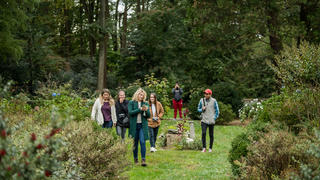Class is in Session: Sculpture and the Environment
Steven Rossi, assistant professor of art, is working with students in his Sculpture and the Environment course to collaborate on art-making at The Barnes Arboretum while focusing on environmental ethics.

In the University’s new Sculpture and the Environment course, Steven Rossi, assistant professor of art, is leading students in a collaborative, art-making effort that explores connections between art and the world around them, namely the environment of The Barnes Arboretum at Saint Joseph’s University.
Ultimately, the class will be working to construct sculptural seating for the Arboretum utilizing three-dimensional design principles and woodworking techniques. Students will also have the option to incorporate habitats for native animal species like garter snakes, bees, songbirds and (perhaps most appropriately) hawks who are relied upon to help maintain the arboretum in their own way.
At the start of the semester, Rossi’s students examined the work of contemporary artists who address environmental themes in their work, like Slovenian artist Marjetica Potrc, whose project Between the Waters built an entirely passive water purification system for a community in Essen, Germany.
Similar to Potrc’s work, Rossi’s course aims to raise student’s awareness to artistic endeavors utilizing meaningful and impactful art-making processes that situate community building and sustainability at their core.
“Our discussions have really pushed each of us to consider our role in nature,” confirms Elizabeth Wash ’22, who is currently enrolled in the course while double majoring in art and biology. “The reading we’ve done for class has introduced a lot of ethical debates among us.”
To bring the course to life, Rossi had to apply for an ethics overlay certification with SJU governance after it was approved by the University’s art and art history department.
Saint Joseph’s core requirements created a unique opportunity for Rossi to approach the course using innovative pedagogy that makes this class unlike others you’d find in a higher ed art department.
As Rossi explains it, typical visual arts courses discuss and present material using traditional studio art pedagogy, which focuses on content, aesthetics and technique.
But does not specifically address further exploration into various philosophical and ethical frameworks related to environmental ethics that can help to inform decision making on the public policy level.
Wash says she appreciates the bridge that this class provides between a person’s duty to the living world and the ways in which aesthetics can be found in nature or used to augment it. One of the first projects she worked on in the course was using organic materials found on the Arboretum grounds for printmaking.
I love being able to explore how there is existing intrinsic value in the aesthetics of the natural world while working to uphold the environment and the ecosystems that make it up.
Elizabeth Wash '22
“The idea of finding beauty in nature really resonates with me,” says Wash. “I love being able to explore how there is existing intrinsic value in the aesthetics of the natural world while working to uphold the environment and the ecosystems that make it up.”
Wash is one of the more experienced art students taking the course, but not all her peers in class are art savvy.
“What’s really interesting about the class make-up is that the course is open to all students, not just art majors,” notes Rossi. “And it's a collaborative course, so it has been really fun to watch the groups ideate together and to help facilitate that process.”
Rossi grouped the students by evenly distributing the veteran art majors with those less experienced in the cohort.
Jennifer Walker, the head gardener at the arboretum, has identified different sites on the property where she would like the students to engage the landscape with sculptural interventions.
“The arboretum is 12 acres, but contains a wide variety of smaller spaces that represent different garden and ecosystem types,” says Walker. “Having sculptural seating in more areas encourages students to visit and linger a bit, enjoying the peace of their campus and observing the natural world.”
Aside from the arboretum, Rossi notes there are many cross-departmental partnerships to be made to elevate and enhance this course’s offerings.
Rossi is also interested in involving Saint Joseph’s biology faculty as a way to better inform the creation of sculptural habitats meant to attract and accommodate different species to the arboretum. Rossi would also like to have students work with the Saint Joseph's Community Garden to design and build sculptural trellises to support their climbing vegetables growth .
“There's been a shift in terms of authorship within the field of contemporary art where artists are less interested in being seen as these solo geniuses and more interested in being facilitators or community organizers, in a sense,” says Rossi. “And this course connects that concept to all the really important environmental concerns that the planet is facing right now.”



